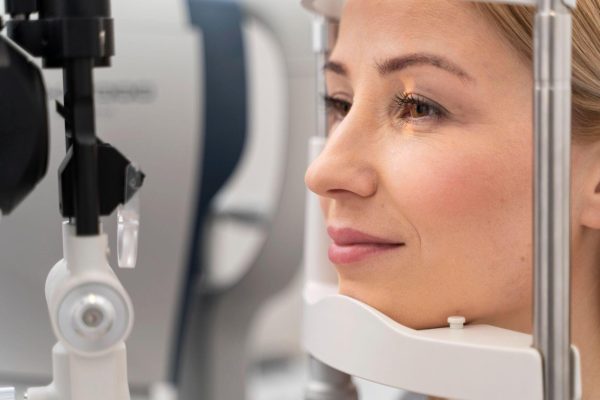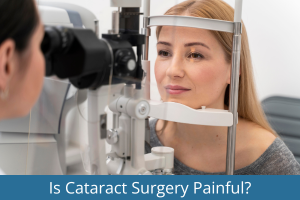Cataract Surgery in Patients with Glaucoma
Welcome to Clarity Eye Surgeons, where your eye health is our top priority. In this article, we will explore the complexities of cataract surgery in patients with glaucoma. These two common eye conditions often co-exist and require specialised care for optimal results. We will guide you through the process, from understanding these conditions to managing your recovery.
Understanding Cataracts and Glaucoma
Cataract and glaucoma, two common eye conditions, can affect your vision as you age. Cataract is a clouding of the natural len. This results in blurred vision, difficulty with bright lights, and faded colours. The good news is that cataracts can be effectively treated with surgery.
Glaucoma is a stealthy condition that often goes unnoticed until it is in advanced stages. Glaucoma is characterised by damage to the optic nerve, leading to vision field loss. The tricky part is that glaucoma does not always show early symptoms, making regular eye exams crucial for early detection.
A complexity arises when someone has both cataracts and glaucoma. Managing these conditions together, especially when considering cataract surgery, requires specialised care.
Assessing Glaucoma Before Cataract Surgery
Before undergoing cataract surgery, it is crucial to assess the status of intercurrent glaucoma. Specialised tests and evaluations will help your ophthalmologist determine the best approach. Measuring intraocular pressure (IOP), assessing the optic nerve, and evaluating your visual field are part of the comprehensive evaluation.

Cataract surgery in patients with coexisting glaucoma presents unique challenges and opportunities. Glaucoma often requires strict control of intraocular pressure (IOP), and cataract surgery can influence pressures. Careful preoperative assessment, surgical technique selection, and postoperative management are essential.
To address both conditions simultaneously, innovative approaches like Minimally Invasive Glaucoma Surgery (MIGS) have emerged. MIGS procedures aim to maintain IOP control while treating cataracts, streamlining the surgical process and potentially reducing the need for additional glaucoma medications.
Minimally Invasive Glaucoma Surgery (MIGS)
Minimally Invasive Glaucoma Surgery, commonly known as MIGS, represents a significant advancement in the management of glaucoma, particularly for patients undergoing cataract surgery. Unlike traditional glaucoma procedures, MIGS is characterised by its minimally invasive nature, resulting in shorter recovery times and fewer complications.
MIGS procedures encompass various innovative techniques and devices designed to control intraocular pressure (IOP) by improving the eye’s natural drainage system. These procedures are often performed concurrently with cataract surgery, making them a practical and efficient option for patients with both conditions.
By reducing the need for additional glaucoma medications and invasive surgical interventions, MIGS offers a more patient-friendly approach to managing glaucoma. This section explores the different MIGS procedures, their benefits, and how they are integrated into cataract surgery for improved patient outcomes.
Recovery After Cataract Surgery
The recovery process is a crucial phase in your journey to better vision. After cataract surgery, you might experience some discomfort, this is common and usually temporary. Common symptoms include mild pain, itchiness, and sensitivity to light. These typically
subside within a few days to a couple of weeks.
To ensure a smooth recovery after cataract surgery, follow your surgeon’s postoperative care instructions diligently. Rest, avoid strenuous activities, and use prescribed eye drops as directed. Attend follow-up appointments, where your surgeon will assess your progress and address any concerns you may have.

Benefits and Outcomes
Simultaneously addressing cataracts and glaucoma through cutting-edge approaches offers a multitude of advantages, redefining the future of eye health:
● Improved Vision: Patients often report significantly enhanced visual clarity and quality of life post-surgery.
● Reduced Medication Dependence: Minimally Invasive Glaucoma Surgery (MIGS) can decrease the reliance on glaucoma medications, simplifying daily routines.
● Streamlined Recovery: MIGS minimises postoperative complications, accelerating healing and reducing downtime.
● Enhanced Patient Comfort: The holistic approach of managing both conditions in one surgery means fewer medical visits and reduced stress for patients.
● Comprehensive Care: Treating cataracts and glaucoma concurrently ensures comprehensive eye health management, promoting long-term well-being.
Risks and Complications
While addressing cataracts and glaucoma simultaneously offers numerous benefits, it is essential to be informed about potential risks and complications:
● IOP Fluctuations: Managing IOP can be delicate, potentially leading to spikes or drops that require vigilant monitoring.
● Infection and Inflammation: Post-surgery, there is a small risk of eye infection. Inflammation is common from surgical trauma, and is managed with anti-
inflammatory drops.
● Vision Variations: Temporary fluctuations in vision can occur as the eye heals.
● Suboptimal Outcomes: In some cases, results may fall short of expectations.
● Secondary Interventions: Additional procedures may be needed to optimise outcomes.
It is crucial for patients to have realistic expectations, maintain open communication with their healthcare providers, and adhere to recommended postoperative care to minimise these risks and complications.
FAQs
Cataracts are a common eye condition where the eye’s natural lens becomes cloudy, resulting in blurred vision and other visual disturbances. Glaucoma refers to a group of eye diseases characterised optic nerve damage and visual field loss. Intraocular pressure is a modifiable risk factor for glaucoma.
Both conditions may have common symptoms like blurred vision and difficulty with glare, but a comprehensive eye examination, including tests for IOP and optic nerve health, is essential for an accurate diagnosis of glaucoma.
Yes, it is relatively common for individuals to have both cataracts and glaucoma, particularly as they age.
Cataracts and glaucoma can coexist, and the presence of one condition can influence the management and outcomes of the other. Managing both conditions together is a complex yet essential approach. In some cases, cataract itself can cause glaucoma. In addition, glaucoma treatment can lead to cataract.
Cataract surgery can affect intraocular pressure (IOP), which is a critical factor in glaucoma management. Special considerations are needed to address these changes during and after cataract surgery.
MIGS refers to innovative, minimally invasive procedures designed to manage glaucoma while treating cataracts. These techniques aim to reduce IOP, simplifying the management of both conditions and potentially reducing the need for additional glaucoma medications.
Other surgical techniques and medications can be considered, but MIGS is a less invasive option that many patients find beneficial.
The recovery process involves mild discomfort, and vision may fluctuate initially. Diligent postoperative care, including eye drops and follow-up appointments, is essential for a smooth recovery.
Risks include IOP fluctuations, infections, inflammation, and temporary vision changes. These can be managed through careful postoperative care and
communication with your surgeon.
Seek a qualified ophthalmologist experienced in both cataract and glaucoma surgery. Ask for recommendations from your eye care provider and research the reputation and expertise of the clinic. Here is the comprehensive guide for choosing the right surgeon for cataract and glaucoma.
Simultaneous surgery offers lasting benefits, such as improved vision and possibility of reduced dependence on glaucoma medications, leading to a more comfortable and convenient lifestyle.
Maintain a healthy lifestyle and follow your surgeon’s recommendations for eye health. Regular eye check-ups are essential to monitor your eye conditions.
Conclusion
Cataract surgery in patients with glaucoma is a complex but manageable process. Early diagnosis and a comprehensive approach to both conditions can lead to improved vision and a better quality of life. At Clarity Eye Surgeons, we are dedicated to providing you with the best care and guidance on your eye health journey.
Author Bio
Dr Parth Shah is a leading ophthalmologist in Canberra, specialising in cataract surgery and strabismus surgery. With extensive training and experience, he is renowned for his expertise in the field. Dr Shah is dedicated not only to performing successful surgeries but also to patient education. His compassionate approach, combined with technical proficiency, has earned him the trust and gratitude of countless patients. He is a true advocate for eye health and a trusted name in the Canberra ophthalmology community.
Other blogs related to Cataract

Is Cataract Surgery Painful?
Is Cataract Surgery Painful? Embarking on the journey towards better vision often raises concerns and questions, especially when it comes to surgical interventions. One such

Everything about Cataracts & Surgery: A detailed guide
Everything about Cataracts & Surgery: A detailed guide Cataracts are a common worry, especially as we get older. Imagine your eye’s natural lens gradually getting

Choosing Your Path to Cataract Surgery: Private or Public Practice
Choosing Your Path to Cataract Surgery: Private or Public Practice Deciding to have cataract surgery is a big deal, and opting to have the procedure

A Comprehensive Guide to Choosing the Right Intraocular Lens (IOL) for Cataract Surgery
A Comprehensive Guide to Choosing the Right Intraocular Lens (IOL) for Cataract Surgery Cataract surgery is a common and highly effective surgical procedure aimed at

Cataract Surgery in Patients with Diabetes: A Comprehensive Guide
Cataract Surgery in Patients with Diabetes: A Comprehensive Guide Cataracts are a common concern for many, but for individuals with diabetes, the journey through cataract

Driving With Cataract and After Cataract Surgery
Driving With Cataract and After Cataract Surgery Driving is a significant part of our lives, offering freedom and independence. But to drive safely, one’s vision

Cataract Surgery in Patients with Glaucoma
Cataract Surgery in Patients with Glaucoma Welcome to Clarity Eye Surgeons, where your eye health is our top priority. In this article, we will explore

The Complete Guide to Cataract Surgery Recovery: Timeline, Tips, and What to Expect
The Complete Guide to Cataract Surgery Recovery: Timeline, Tips, and What to Expect Cataract surgery is a common and highly effective surgical procedure aimed at

How to Choose a Cataract Surgeon: A Comprehensive Guide
How to Choose a Cataract Surgeon: A Comprehensive Guide When it comes to your eye health, selecting the right cataract surgeon is of utmost importance.

Cataract Surgery in Children: Symptoms, Causes, Procedure, Risk and Recovery
Cataract Surgery in Children: Symptoms, Causes, Procedure, Risk and Recovery Cataract surgery in children is a delicate procedure that can restore a child’s vision. Learn
